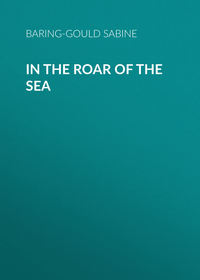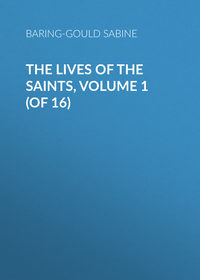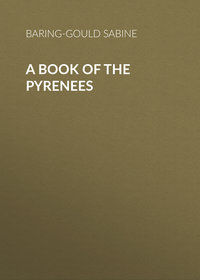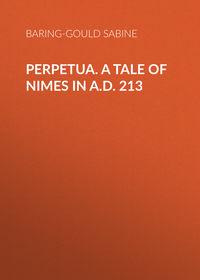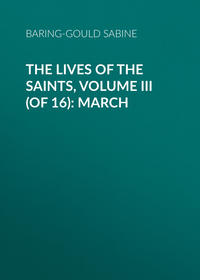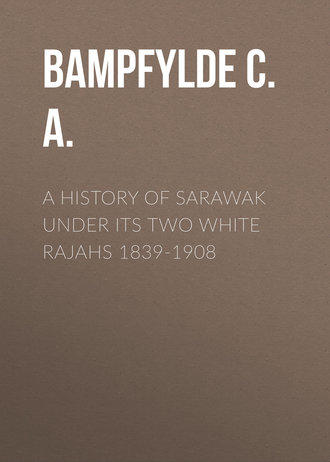 полная версия
полная версияA History of Sarawak under Its Two White Rajahs 1839-1908
195
These are titles of Sanskrit origin bestowed by the Sultan, the meanings of which are somewhat obscure. The first probably means "the revered Lord"; the third "high in eminence"; as regards the second, Pelawan may mean the name of a place, otherwise it is untranslatable.
196
Apai = the father of.
197
As in the case of Mr. Lee, little has been recorded of Mr. H. Steele. He did good service at the battle of Beting Maru, and probably joined in 1848. He was selected by the Rajah to take charge of the fort at Kanowit when it was built, and there he was murdered in 1859. He was a noted linguist.
198
Brass cannon of Malay manufacture.
199
Seman was a Kalaka Malay living in Kuching, and had been made a penglima by the Rajah for his courage and dash. His name still survives in Kampong Penglima Seman – the village, or parish, of Penglima Seman, within the township of Kuching.
200
The brutal and disgusting behaviour of the women on the arrival of a fresh "trophy," to one who has witnessed it, would choke off any pity for them.
201
These articles and other valuables, though a bitter loss, can be replaced. But the destruction of their homes, rice-stores and standing crops, household goods, cooking utensils and clothing, pigs, poultry, and hunting dogs, boats and paddles, and farming implements are losses that it takes two years to regain, and which reduces them for the time to a condition of beggary.
202
Sauh Besi, a powerfully built Malay.
203
Sandom was the guide. He was a plucky Sekrang Dayak, and thirsted for Rentap's blood in revenge for the murder of his brother, who had been put to a cruel death by Rentap.
204
His nom de guerre, or ensumbar in Dayak, was Mua-ari, literally the Face of the Day. He was sometimes foe and sometimes friend, and will be mentioned again. The ensumbar is frequently, not always, given to or adopted by warriors who have in some way or another gained renown. Some writers have confused it with the julok, or nickname, which refers to some bodily defect or peculiarity, and with names given to children at birth, such as Tedong, the cobra; Bulan, the moon; Matahari, the sun; Besi, iron. Malays are sometimes given a nom de guerre, such as Sauh Besi, above mentioned, and Sherip Sahap was known as Bujang Brani, the Brave Bachelor, which is also a Dayak ensumbar; others are the White Hawk, the Hovering Hawk, the Torrent of Blood, etc. The totem is unknown amongst the Sea-Dayaks.
205
John Channon, a merchant seaman, served the Government for many years. Of him the Tuan Muda wrote in 1859: "John had been my companion for many dreary months in the hot cabin of his vessel. He had charge of the Jolly for years, and many a creek and dangerous cranny had she become acquainted with in our expeditions. His valuable services, as well as steady and brave conduct, both on board and in the jungles, cannot be too highly praised in the annals of Sarawak."
206
James Brooke Cruickshank, a godson of the Rajah. He joined in February, 1856, when about fifteen years of age; and at this time was stationed in the Sadong. He served for many years in the Dayak countries; and ultimately became Resident of the 3rd Division. He retired in 1875, and died in 1894.
207
Mr. W. C. Watson joined October, 1857, and resigned in 1869.
208
Nanga = the mouth of a river in Sea-Dayak; tiga = three.
209
Mr. C. Fox came to Sarawak from India in 1851, as master of the Mission School; he shortly afterwards joined the Rajah.
210
Hueh, or Hui, is the Chinese word for a secret society.
211
Tien, heaven – ti, earth.
212
It is still part of the oath of the initiated, "I will use my utmost endeavour to drive out the Chheng and establish the Beng dynasty." – "Pickering, Chinese Secret Societies," in the Journal of the Straits Branch of the Royal Asiatic Society, 1878.
213
Pickering, who knew a good deal about the Society and wrote thereon, had his life attempted, and, though not killed, was badly crippled.
214
Tai-pi-kong was the name of the joss.
215
The Chinese, holding the Rajah to be invulnerable, and being greatly in fear of him, purposely left the exit by the door of the bathroom unguarded.
216
He had joined the Sarawak service the year before. He was a brother of Colonel Nicholetts, who was married to a sister of the present Rajah.
217
A Mr. Wellington was killed trying to defend Mrs. Middleton and her children. He was a clerk in the Borneo Company, and had only lately joined.
218
St. John says thirty-seven, five of whom died before the Bishop's arrival.
219
Spenser St. John, Life of Sir James Brooke, to whom we are mainly indebted for the following particulars we give of the insurrection.
220
A Saribas Malay Chief, and a staunch supporter of the Government.
221
Ten Years in Sarawak.
222
Sir Spenser St. John, op. cit.
223
Sir Spenser St. John, Rajah Brooke.
224
The Rajah to Mr. Templer.
225
Three Dots.
226
In addition to their other duties in the capital. See list of titles, p. xi.
227
See chap. iii. p. 77, for particulars of these Datus.
228
The Datu Patinggi Abdul Rahman was the rightful Malay chief of the Rejang, and the Sultan's representative. Sherip Masahor had originally settled at Igan, which place, with the surrounding district, belonged to him. At Serikei he was an interloper. He usurped authority wherever he could do so, and the Sultan, whose power in the Rejang was but a shadow, was constrained to put up with the Sherip's pretensions.
229
This is incorrect. On more than one occasion he greatly distinguished himself fighting for the Government, especially at the time of the Chinese insurrection, but he died a natural death.
230
An error – he was the Bandar's brother-in-law.
231
He did not change his title. There has been no Datu Patinggi since.
232
Haji Bua Hasan, who afterwards became Datu Bandar (vide Chap. III. p. 77). It was not until 1860 that he was raised to the rank of Datu under the title of the Datu Imaum.
233
His was a turbulent nature; a useful man in the time of trouble, but apt to be troublesome in the time of peace. He had some fine qualities, being brave and staunch, but even his best friend could not have called him honest. A well-built muscular man, never ruffled, and utterly impervious to fear, but somewhat cold-blooded – he was covered with the marks of old wounds. When Muka fort was built, he was appointed to be native Magistrate under the Resident, but he was removed in 1868, being unprincipled, dishonest, and unjust (to quote the present Rajah). He was invaluable in dealing with the turbulent Dayaks in the upper waters of the Rejang, as they absolutely feared him, but he could not keep his hands clean, and had to be removed from Baleh in 1876, when he was pensioned and placed out of harm's way at a little village near Santubong. He was a staunch supporter of Government and a hard fighter in helping to maintain it; he died some twenty years ago.
234
Chap (Hindustâni) meaning a seal. Hence a firman, edict, licence, grant.
235
See Chap. III. p. 87.
236
A young man then, and one of the well disposed Malay chiefs of Serikei. He shortly afterwards became the principal native officer in the Rejang, a position which he held until his death in 1874. He earned the fullest confidence of the Government, and the respect not only of his own people, but of the Dayaks, Kayans, and other tribes.
237
A schooner belonging to the S.P.G. Mission.
238
The national method of execution.
239
From a letter from the Tuan Muda to his uncle, giving an account of these events, it is, however, evident that Haji Gapur had wheedled himself into the Tuan Muda's good graces, and had to a large extent regained his confidence. The Haji begged to be with him, and was taken.
240
A Singapore Malay, better known as Inchi Subu. He was one of the Malay sailors engaged by the Rajah to serve on the Royalist when he first arrived at Singapore. He was remarkable for his size and strength. He became personal orderly to the late Rajah; and afterwards to the present Rajah, and was also the executioner. A brave and trustworthy man, he was generally popular with Europeans as well as natives. He died some years ago.
241
Afterwards re-interred in the Kuching cemetery.
242
A Court set apart for the settlement of Probate and Divorce cases and other civil suits arising amongst Muhammadans, and which are settled in accordance with Muhammadan law. Presided over by the Datus.
243
A relation of the Datu Haji. He had been very active inciting the people of Lundu to revolt.
244
It must be borne in mind that Rentap was still at Sadok defying the Government.
245
Messrs. Watson and Cruickshank at Saribas, and Mr. Grant at Belidah. In Kuching Messrs. Crookshank, R. Hay (who had joined in May 1857), and Alderson, a son of Baron Alderson, who served for a short time only.
246
Life of Sir James Brooke.
247
He was better known in later days as the Datu Bandar.
248
Ten Years in Sarawak.
249
The Sultan of Bruni affirmed to Consul-General St. John that the Sherip was responsible for the murder of Steele and Fox.
250
A pension of 300 reals per mensem had been offered to any one taking the Tuan Muda's head; the danger attached to such an undertaking was evidently duly appreciated.
251
"Sarawak became virtually a protected State. Her ruler was appointed a public officer of the Crown, and such unequivocal countenance and support were given as to assure the natives, and to induce British subjects to embark their lives and fortunes in the country." – The Rajah to the Secretary of State for the Colonies. Nevertheless protection and support were withheld.
The Governor of Singapore sent the H.E.I.C.'s steamer, Hooghly, in November 1859, to safeguard British interests, but there was no need of her services then, and she left almost immediately.
252
From Miss Jacobs, The Raja of Sarawak.
253
Referring to the protection of France.
254
Miss Jacobs, op. cit. For a special account of this Company see Chap. XVI.
255
Sir Thomas Fairbairn, Bart.
256
Life of Sir James Brooke.
257
Idem.
258
Extracted from Governor Edwardes' letter to the Tuan Besar of May 25, 1860.
259
A sailing gunboat of 50 tons, just launched, and manned with a crew of twelve Englishmen and twenty Malays.
260
Dagang, a brave Balau Dayak, who subsequently filled many positions of trust, as Police Sergeant and native officer, now retired on pension.
261
The Telian.
262
Under the pretext of "having a proper regard for British interests, and the honour of my country." – Governor Edwardes to the Tuan Besar, July 31, 1860.
263
St. John, op. cit.
264
St. John, Life in the Forests of the Far East.
265
Ten Years in Sarawak.
266
Youngest son of the Rev. Charles Johnson. He was at first styled Tuan Adek but this was afterwards changed to the more correct Malay title of Tuan Bongsu, now held by the present Rajah's third son. (Adek = younger brother; bongsu = youngest born.) He served principally in the Saribas, until 1868, when his health having broken down he retired. He became Deputy-Governor of Parkhurst and Chatham Prisons in succession, and then Chief Constable of Edinburgh. He died March 31, 1894.
267
St. John, Life of Sir James Brooke.
268
From a letter to the Tuan Muda of May 5.
269
St. John, op. cit.
270
He retired in 1863.
271
St. John, Life of Sir James Brooke.
272
By Article III. of the Treaty of May, 1847, the British Government engaged to use every means in their power to suppress piracy within the seas, straits, and rivers subject to Bruni.
273
Miss Agnes Brooke.
274
Some were from the Celebes; some from both Southern and Western Borneo; some Javanese; some from the Natuna islands. Amongst them were a nadoka and the crew of a Singapore vessel, and a Malay woman of Singapore and her family. (From an account by the Rajah Muda, which is practically the same as the Bishop's.)
275
Some fifty people from Matu, Oya, and Muka were rescued.
276
Belitong.
277
Ruah Selamat – a prayer of thanksgiving. The pirates now calculated upon being quit of men-of-war, and that the rest of their voyage would be free from danger.
278
There were many more people captured between Bruit and Bintulu, but the narrator probably only knew of those captured by the prahu on board of which he was a prisoner; he is at fault, too, as to the number of pirates killed, and captives rescued.
279
From a letter of the Rajah's dated September 9, 1862.
280
Mr. G. T. Ricketts was appointed Consul, January 19, 1864.
281
Captain Brooke died the same year as the Rajah.
282
Oyong Hang was the chief of the Bintulu Kayans, and was at one time friendly to the Government, but he had thrown off his allegiance and joined Akam Nipa.
Oyong is prefixed to the name of a Kayan on the death of his firstborn; Akam, on the death of a younger child.
283
Ten Years in Sarawak, from which this account is taken.
284
See chap. vii. p. 107.
285
For the fate of this chief see chap. xii. p. 320.
286
Belaga, where is now a strong fort, and a Chinese and Malay trading station, is just above this.
287
The village of the Kajaman tribe, a short distance above Belaga.
288
Talip was a Matu Melanau of good birth; Sakalai was a chief of the Kanowit tribe; and Sawing was half Ukit and half Tanjong.
289
Lord Palmerston, Debate in House of Commons, July 10, 1851.
290
Sir Spenser St. John says that, "ever since our Mission to Siam (of which the Rajah was the head, having been appointed Special Envoy by the Government) in 1850, Chaufa Mungkat (then Prime Minister, but very shortly afterwards he became the King) had kept up a private correspondence with the Rajah of Sarawak, in whose doings he showed great interest." This King afterwards presented the Rajah with a Siamese State barge, still in use, and a gold snuff-box. We mention this to show the power of the Rajah's influence, and to what good purposes that influence might have been put.
291
British Malaya, p. 71; Sir Frank Swettenham, K.C.M.G.
292
Extract from a letter to Lord John Russell, dated December 10, 1859.
293
The Land-Dayaks of the Sadong, Sarawak, and Lundu rivers.
294
Mr. Templer to the Tuan Muda, March 1872.
295
Built in Singapore, and commissioned in September 1865.
296
Launched in March 1867.
297
Rajah Brooke.
298
This was the first meeting of the Council.
299
Literally, an elder.
300
The poor creatures being solemnly admonished to attend well upon their masters in the next world.
301
They held the power of life and death over their slaves.
302
See chapter x. p. 287.
303
This number includes the Kayan, Kenyah, and other inland warlike tribes.
304
Afterwards Major Commandant S. R., joined the service 1862, retired 1883.
305
Joined 1868; resigned 1873. He was at this time Assistant Resident of Bintulu, and was at Muka on a visit.
306
The last in 1902.
307
Built in 1863, when it became the Government headquarters in the Rejang. Sibu is the most important provincial town, and has a revenue larger than that of Labuan.
308
Henry Skelton, joined 1866, died in 1873, immediately after being appointed Resident of Sarawak.
309
Forests of the Far East, S. St. John.
310
Formerly of the Royal Navy, and the Labuan Civil Service. Joined the Sarawak Civil Service 1871. Was Resident at Muka, and subsequently Divisional Resident of the 3rd Division. Died 1884.
311
St John's Forests of the Far East.
312
It will be remembered that in 1849 the late Rajah, as her Majesty's Commissioner, had concluded a treaty with the Sultan of Sulu, but this had to be ratified within two years. The British Government, however, would not place a man-of-war at the Rajah's disposal, and he was unable to proceed to Sulu to effect this necessary ratification. The Spaniards, by force of arms, enforced another treaty upon Sulu, and before those two years had expired. But the British Government took no interest in Sulu, and this was allowed to pass unheeded.
313
He had succeeded Mr. Pope Hennessy, and was Mr. Ussher's predecessor.
314
Named after the late Mr. C. A. C. de Crespigny.
315
In a great degree due to the able administration of Mr. Charles Hose, D.Sc., who served in this district for twenty years, during sixteen of which he was Resident in charge. In 1904 he became Divisional Resident of the 3rd Division; he retired in 1907.
316
Joined 1872; was Assistant Resident, and Resident of Batang Lupar and Saribas, and in 1881 became Divisional Resident of Sarawak proper. He retired in 1895, and died in 1897.
317
See footnote, p. 69.
318
Sir Hugh Low, G.C.M.G., who was then British Resident of Perak, had for many years been Colonial Secretary at Labuan.
319
These had long ceased.
320
Mr. Ricketts, who is a son of the first British Consul to Sarawak, joined in 1881.
321
Now Managing Director of the British North Borneo Company.
322
For this reason a large number of Malays, men, women, and children, in April, 1904, moved into the Limbang. The men were the ironsmiths of Bruni, and this useful class was forced to leave to save their girls. And because some of their women had been seized and sold, the Kadayans of Bruni, who in former days had been the faithful followers of the Sultans and their main support, revolted in 1899.
323
Two years previously a Sarawak Chinaman was murdered in the Belait, and that this was done at the instigation of an Orang Kaya, solely in the expectation that the murder of a Sarawak subject would lead to such active interference by the Government of that country in the affairs of the district that might end in annexation, was proved in a Court of inquiry held at Claudetown.
324
Many of the peaceable Kadayans removed into the Limbang, having been driven from their homes, with the loss of all their property, by an emissary of the Sultan, for refusing to join him in an attack on the rebels.
325
Sarawak and British North Borneo.
326
High Chamberlain.
327
In reply to a question on December 15, 1906, by Sir Edward Sassoon, the Under-Secretary for the Colonies found it convenient to take no notice of Sir Edward's reference to the F.M.S. in this connection.
328
To quote the present Secretary for Foreign Affairs when addressing the House, but a few years ago upon the subject of an export duty on English coal.
329
Lit. upper waters.
330
Chap. XII. p. 320.
331
A large town in the Upper Kapuas – the Dutch headquarters there.
332
In 1871 there were only 3000 families of Sea-Dayaks in the Rejang, there are now over 8000.
333
Mr. Deshon joined the Sarawak service in 1876. In 1883 he was appointed Resident of Batang Lupar and Saribas; Divisional Resident of the 4th Division in 1892; of the 3rd Division in 1896; and in 1903, he succeeded Mr. C. A. Bampfylde as Resident of Sarawak. He retired in 1904, and was succeeded by Sir Percy Cunynghame, Bart., the present Resident.
334
Entered the Sarawak service in 1888. Resident of Batang Lupar and Saribas 1894.
335
They could not bury their dead in an enemy's country – the bodies would have been dug up and the heads taken.
336
Then Resident 2nd Class 2nd Division. Now Resident of the Rejang. He joined the service in 1897.
337
The Sarawak Gazette.




